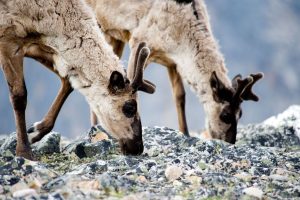UCP neglects caribou, sacrifices future for short-term gain, critic says

Mountain woodland caribou, like these ones in Jasper National Park, are being put at heightened risk in the Upper Smoky subregion, the NDP says. Alamy stock
By George Lee, Local Journalism Initiative Reporter
Originally published on Sep 27, 2025 at 05:15
A UCP lack of foresight threatens caribou populations and undermines Alberta’s economic future, an opposition critic has charged.
Sarah Elmeligi, the NDP’s shadow minister of environment and protected areas, said the government puts too much emphasis on today’s human-focused demands on caribou habitat.
“The government is really focused on short-term gains, and they’re not even really good at that,” said Elmeligi, the NDP member for Banff-Kananaskis.
“We’re foreclosing options for future generations to have clean water, to have caribou in the landscape, to have abundant recreational opportunities on public lands and to have a strong economy.”
She continued: “I think a strong economy and a healthy environment go hand-in-hand. The UCP does not.”
Rebecca Schulz, Alberta’s minister of environment and protected areas, said in an interview earlier this summer that fixes for caribou populations aren’t simple.
“This is one of the more challenging areas of work my department does. It is exceptionally complex,” she said June 25.
Schulz said “a variety of views and perspectives” are at play, as the province tries to strike a balance that also allows it to create jobs, double energy production and mitigate wildfire risk.
Premier Danielle Smith announced in January that the government aims to double Alberta’s production of oil and gas.
Schulz, the UCP member for Calgary-Shaw, said habitat restoration is one of three approaches the province takes, when it comes to caribou survival. Also important are predator management and, through things like the penning of pregnant females, the management of caribou themselves.
Her comments followed a June announcement that the UCP government is putting $55.8 million towards planting five million trees along so-called legacy seismic lines by 2030.
About 1.8 million kilometres of the lines, some dating from the 1940s, have been carved through Alberta’s vegetation, putting many of the province’s 2,000 or so remaining caribou at heightened risk by providing pathways for predators.
Since 2019 more than 4,500 km of seismic lines have been assessed and treated in caribou ranges, including 2,400 km in the past 20 or so months. The government uses the word “treated” because full restoration happens over time, after the appropriate trees are planted in properly prepared places.
The latest funding is the Alberta portion of a partnership with Natural Resources Canada. It has the provincial government working with Indigenous communities and other organizations, many in the northern end of the province, to plant trees along seismic lines prioritized for their impact on caribou.
The government has said caribou populations are “finally stable or even growing” in Alberta.
Elmeligi acknowledged that restoring seismic lines is important. “Linear disturbance is a big problem. It fragments habitat and it gives wolves access to caribou ranges. So of course, restoring seismic lines, planting trees, all that stuff, is important,” she said.
But the program isn’t rapid enough to make much difference, she said. “We need to ramp up restoration of those seismic lines in a really significant way if we want to have a positive impact on caribou habitat.”
In 2020 Alberta and Canada signed a five-year agreement to support the conservation and recovery of caribou to naturally self-sustaining status in 50-100 years. That would mean achieving and maintaining at least 65 per cent undisturbed caribou habitat.
On its website, the northern Alberta chapter of the Canadian Parks and Wilderness Society says achieving 65 per cent will be “no small feat, with some caribou ranges in Alberta more than 90 per cent disturbed.”
Human encroachment, wildfires, logging, and oil and gas development are among habitat threats across Alberta’s 15 woodland caribou ranges.
Subregional land use plans are key instruments the province is using to address the future of caribou habitats. So far, two of 11 are complete and approved — Cold Lake in east-central Alberta and Bistcho Lake in the northwest corner.
Elmeligi is unimpressed with the draft form of a plan for a subregion called Upper Smoky, saying it’s “really problematic.”
The area extends south from near Grande Prairie to south of Grande Cache, overlapping the Redrock-Prairie Creek and Narraway mountain woodland caribou ranges.
“The Upper Smoky plan is not a win-win. It’s a win for forestry,” said Elmeligi.
About two thirds of the last southern mountain caribou in Alberta could see their winter range habitat clearcut, she said.
The draft acknowledges that “the abundance and occurrence of woodland caribou along the eastern slopes of Alberta has dramatically declined in recent decades, with only three populations remaining on provincially managed land.”
The plan doesn’t include population restoration goals. “If you create a plan that isn’t designed to recover caribou, guess what? You probably won’t recover caribou,” said Elmeligi.
Approved subregional plans have shortcomings but are better than Upper Smoky, Elmeligi said.
“I haven’t met a single caribou biologist who thinks it will actually work to conserve caribou,” she said. “In fact it will extirpate two caribou herds in the region.”
Minister Schulz said in the June interview: “It’s not a blanket approach across the province, because we do have different types of caribou in different areas, and, quite frankly, different geology, different industry and different patterns when it comes to wildlife.”
